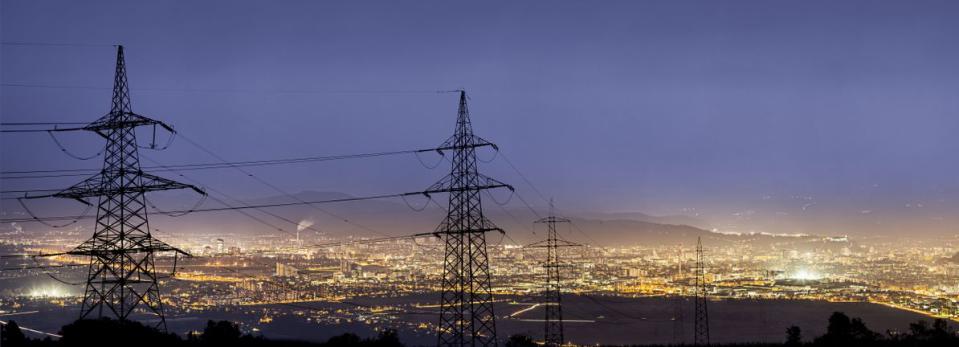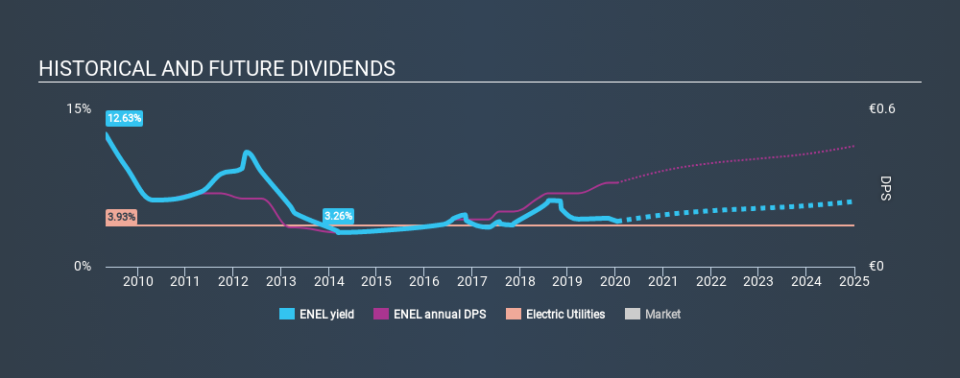It Might Not Be A Great Idea To Buy Enel SpA (BIT:ENEL) For Its Next Dividend

Some investors rely on dividends for growing their wealth, and if you're one of those dividend sleuths, you might be intrigued to know that Enel SpA (BIT:ENEL) is about to go ex-dividend in just 3 days. Ex-dividend means that investors that purchase the stock on or after the 20th of January will not receive this dividend, which will be paid on the 22nd of January.
Enel's upcoming dividend is €0.16 a share, following on from the last 12 months, when the company distributed a total of €0.32 per share to shareholders. Calculating the last year's worth of payments shows that Enel has a trailing yield of 4.3% on the current share price of €7.421. Dividends are a major contributor to investment returns for long term holders, but only if the dividend continues to be paid. So we need to investigate whether Enel can afford its dividend, and if the dividend could grow.
View our latest analysis for Enel
If a company pays out more in dividends than it earned, then the dividend might become unsustainable - hardly an ideal situation. Enel paid out 119% of profit in the past year, which we think is typically not sustainable unless there are mitigating characteristics such as unusually strong cash flow or a large cash balance. Yet cash flows are even more important than profits for assessing a dividend, so we need to see if the company generated enough cash to pay its distribution. Enel paid out more free cash flow than it generated - 194%, to be precise - last year, which we think is concerningly high. We're curious about why the company paid out more cash than it generated last year, since this can be one of the early signs that a dividend may be unsustainable.
Cash is slightly more important than profit from a dividend perspective, but given Enel's payouts were not well covered by either earnings or cash flow, we would be concerned about the sustainability of this dividend.
Click here to see the company's payout ratio, plus analyst estimates of its future dividends.
Have Earnings And Dividends Been Growing?
Companies with falling earnings are riskier for dividend shareholders. If earnings fall far enough, the company could be forced to cut its dividend. Readers will understand then, why we're concerned to see Enel's earnings per share have dropped 6.0% a year over the past five years. Such a sharp decline casts doubt on the future sustainability of the dividend.
The main way most investors will assess a company's dividend prospects is by checking the historical rate of dividend growth. Enel has seen its dividend decline 4.2% per annum on average over the past ten years, which is not great to see. While it's not great that earnings and dividends per share have fallen in recent years, we're encouraged by the fact that management has trimmed the dividend rather than risk over-committing the company in a risky attempt to maintain yields to shareholders.
Final Takeaway
Is Enel worth buying for its dividend? It's looking like an unattractive opportunity, with its earnings per share declining, while, paying out an uncomfortably high percentage of both its profits (119%) and cash flow (194%) as dividends. This is a starkly negative combination that often suggests a dividend cut could be in the company's near future. With the way things are shaping up from a dividend perspective, we'd be inclined to steer clear of Enel.
Curious what other investors think of Enel? See what analysts are forecasting, with this visualisation of its historical and future estimated earnings and cash flow.
If you're in the market for dividend stocks, we recommend checking our list of top dividend stocks with a greater than 2% yield and an upcoming dividend.
If you spot an error that warrants correction, please contact the editor at editorial-team@simplywallst.com. This article by Simply Wall St is general in nature. It does not constitute a recommendation to buy or sell any stock, and does not take account of your objectives, or your financial situation. Simply Wall St has no position in the stocks mentioned.
We aim to bring you long-term focused research analysis driven by fundamental data. Note that our analysis may not factor in the latest price-sensitive company announcements or qualitative material. Thank you for reading.

 Yahoo Finance
Yahoo Finance 
